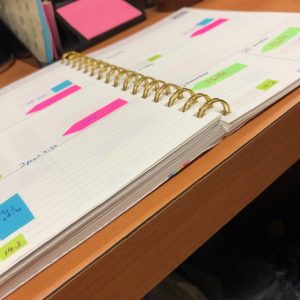Integrating a Day Planner into Writing Planning
 While my spreadsheet (of doom) is my primary method of organization for writing planning and submitting stories, I’m also a fan of redundancy and stickers, hence why I also use a day planner.
While my spreadsheet (of doom) is my primary method of organization for writing planning and submitting stories, I’m also a fan of redundancy and stickers, hence why I also use a day planner.
The day planner I prefer starts each week on a Monday, and has large spaces for weekdays, with smaller spaces for weekends. And while I do often get a lot of writing done on the weekends, there’s still enough space for me to work with on the weekend days. I start out by filling in things I know will happen during the week in pen–appointments, games, days off, and more.
Then I break out the sticky note flags. With these, I can color code my projects, so stories can keep the same color for the life of the project. I also have a lot of sticky note flags that are more generic, so I can repurpose them. For example, blog posts and MSJ edits have large flags that get moved to a future week after I’m done with them. Outlining, writing, and editing novels all have reusable flags, too. And reoccurring projects without titles, like flash fiction that I often cram into the weekends, can also be on reuseable flags. Only individual stories get flags that are removed and discarded as I work on them.
As this sample spread illustrates, on this week, I’ve got three stories I’m working on, coded as blue, pink, and green. I’m also working on a novel, which are the partially clear tags. So there’s one story that I’ll work on Monday and Thursday, another I’ll work on Monday, Tuesday, and Thursday, and a third story I’ll work on over the weekend. (Wednesday and Friday are the evenings I don’t write, though I often work on things during my lunch break on those days.) My spreadsheet of doom divides things out by week, while my day planner lets me break things down even farther, into individual days, which then helps me see what I need to work on during any given evening.
 I also use my planner as a way of tracking what I’ve accomplished, which is something that my spreadsheet setup did not allow for. When I’ve worked on a project, I remove the sticky note flag and jot down what I’ve done. Loosely speaking, the left hand side of each column is what I work on during my lunch break, and the right hand side of each column is what I work on in the evenings. Sometimes things slide in one direction or the other, but it’s a generally standard divide.
I also use my planner as a way of tracking what I’ve accomplished, which is something that my spreadsheet setup did not allow for. When I’ve worked on a project, I remove the sticky note flag and jot down what I’ve done. Loosely speaking, the left hand side of each column is what I work on during my lunch break, and the right hand side of each column is what I work on in the evenings. Sometimes things slide in one direction or the other, but it’s a generally standard divide.
If whatever I’ve done is an accomplishment of some sort (as opposed to more regular work that still deserves a note), I add a sticker! Sometimes that’s hitting a word count, sometimes it’s finishing a story, and sometimes it’s selling a story! I tend to reward myself with more stickers when I’m writing a novel, because that can be a difficult slog that I feel deserves more rewards. I also track novel word count on special stickers I ordered that go in the bottom right hand corner of each week (which aren’t visible in these photos).
The notes and stickers mean that I can look back at a week, a month, or even the year and celebrate what I’ve accomplished all over again. When I get to the end of a week that I feel like has been not very productive, sometimes the notes and stickers say otherwise, which reminds me that sometimes there’s progress even when you don’t feel it!

Comments